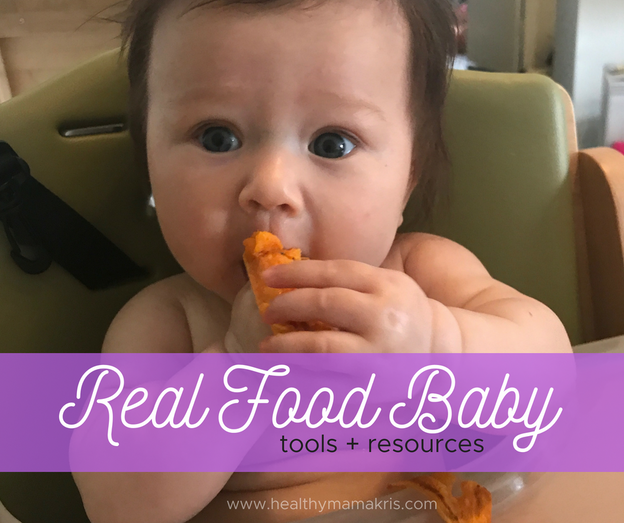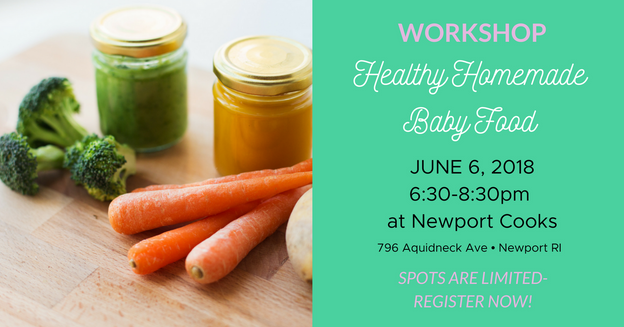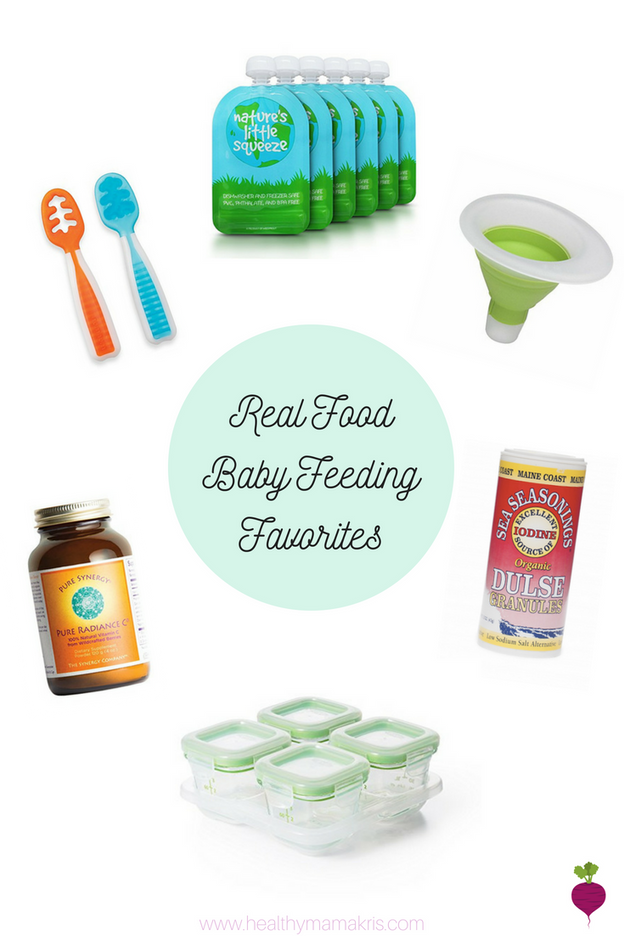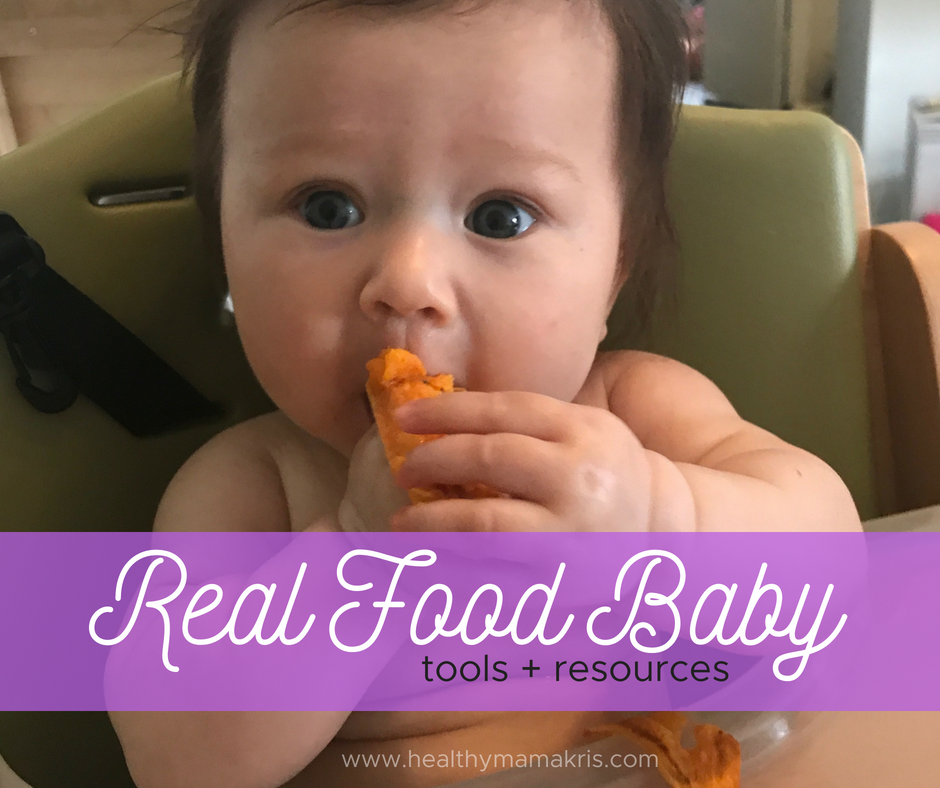
Starting solids can be overwhelming. From when to start (Should I start at 4 months or 6 months? Should I follow the AAP recommendations or simply trust my gut?), to what foods to start with (Rice cereal or Meat? Veggies or Fruit?) and how (Should I start with purees or Baby Led Weaning, or maybe a combination of both? What about allergens?). Whatever way you choose to start feeding is all about what works best for your family, and most importantly- your baby! If there’s one thing I’ve learned along the way with two kids and dozens of clients starting first foods, it’s that every baby is different. Every baby will react to foods differently, every baby will have different preferences. Sage didn’t mind being spoon fed for the first month or so and enjoyed puree packets from the get-go. Wren is a self-feeder all the way (even when it comes to purees!) which has been MUCH, much messier- but such a fun process to experience. Sage didn’t love meat as much, Wren grabbed onto a piece of steak right away. So we adapt, just like you’ll have to adapt- whether you have one kid or ten, first with your expectations, and the with the resources and tools you use to best serve your baby and family. So I thought I would share some of my favorite resources for starting foods- no matter what way works best for your baby.
Resources:
Nutrition
Before you can even start thinking about the how, one thing remains the same no matter what baby you’re feeding, and that is the recommendation to feed baby pure, nutrient dense foods. Nutrition is of utmost importance when it comes to feeding baby, because although breastmilk or formula will provide the bulk of nutrients for baby in the first year, nutrition IS important- babies need specific nutrients- like iron and zinc, especially when they’re first starting solids, so it’s important to make sure they’re getting a variety of nutrient dense, whole foods. But where do you begin? My absolute favorite resource, by far for infant feeding is Megan Garcia’s First Foods and Beyond Course. This course is PACKED with information and resources for starting solids in a nutrient-dense way. Her baby food pyramid, first foods chart and guide to micronutrients were invaluable in ensuring I was giving Wren everything she needed for the best possible start (she goes all the way through the first two years!) And even though we started her on nutrient dense foods, I still wish I had this resource with Sage.

Super Nutrition for Babies:
If there is one book I would recommend for infant feeding, it’s this one. It’s based on the Weston A Price model of traditional foods, so if you’re not familiar, some of the recommendations might seem a bit odd (liver?? really?– YES- it’s super high in iron and zinc!) and it does a good job of sharing what nutrients babies need the most and why, the food sources you’d get them from, how babies have been fed throughout history (and how it’s changed, often for the worse) all with recipes, as well. I definitely recommend it (and it’s like $10!).
Baby Led Weaning
We decided early on we would do a combination of purees and solid foods for both of our kids. We knew the importance of allowing babies to learn to self-feed, but this time around, feeling a little more confident as parents, we decided to included more of them, only utilizing purees for the purpose of getting a more concentrated dose of nutrients. But we had NO idea where to start. I happened to stumble upon the ladies at Feeding Littles on Instagram and I LOVED their feed and their practical advice on teaching babies to self-feed from the start. So I decided to go ahead and sign up for their Babies course, and I even had my husband sit down and take it with me– he found it as useful as I did, too! If you don’t take anything else from this post– go ahead and take Megan’s course for the nutrition advice, and Megan and Judy’s course for the self feeding advice!
You can get $10 off the Feeding Littles Baby Led Weaning Course by using code HEALTHYMAMAKRIS now through May 31st!
Tools:
Feeding baby comes with a whole new set of gear that you may or may not want bombarding your peaceful kitchen. Colorful wipeable bibs and plastic bowls and tiny spoons… but just like everything else with baby, many of these items simply aren’t necessary. Sure, it’s nice to have the latest and greatest baby feeding tools, but by and large- babies can use the same bowls you do, they only need one or two soft spoons, and if you’re like us, you ditch the bibs most of the time in favor of stripping the kiddos down for an easy straight-to-the-bath cleaning at the messiest of feeds. So where I will share some of my favorite tools for feeding baby- remember none of them are truly necessary to feed baby nourishing, healthy foods (and that’s all she really needs!).
Abiie Beyond Wooden High Chair: We love the Stokke chair, but not the price tag! This chair fits the recommendations from Judy (an OT) from Feeding Littles to have a foot rest so their hips are aligned correctly, as well as a removable washable tray (SO good) and removable wipeable pads (invaluable!). We love it!! We found the top straps (five point harness) to be cumbersome, so we just just the three point and Wren has been fine (she’s been sitting fairly independently since the beginning of her solid feeding journey).
Num Num Goo-tensils: These are definitely one of my most-recommended products to friends, and again- it was the Feeding Littles ladies that recommended these pre-spoons! Wren took to them right away, and they’re a great way to serve purees while also encouraging self-feeding.
EZPZ Mat: This is our favorite ‘plate’ so to speak. It’s soft and it suctions to the table or highchair (it is a little big for the Abiie, unfortunately- but it still works!) and it’s sectioned for different food options.
OXO Baby Food Containers: For purees, these are our go-to! They’re glass, so no worries of BPA or other weird chemicals, and you can put hot foods directly in them- they’re a great size, not too big, not too small; they have a tray to hold four at once in the fridge and they’re dishwasher safe. Love!
Munchkin Safety Spoons: When we are feeding Wren purees, even though she tends to grab onto the spoon, we do like using these safety spoons. They change colors with heat, so you know right away if the food you’re offering baby is a safe temperature.
For freezing purees, these are our favorite molds. They’re silicone, with a cover, so they’re safe in the freezer, and they’re easy to pop the little puree balls out and into a silicone ziploc bag to store and re-use the molds.
Baby food packets can be SO expensive. But they can be SO convenient when you’re out and about- and a great way to get nutrients in babies who aren’t loving a ton of foods, yet. So I just make my own using these handy reusable pouches and a mini funnel! So easy!
Other tools: some of my favorite tools for making homemade purees include a simple steamer basket and immersion blender. Yep- that’s it!
Key Nutrients:
I believe babies should get the majority of their nutrients from whole foods, but we are sure to make sure Wren gets supplements where I’m not quite sure she’ll be getting everything she needs. These include:
Fish Oil: Though we encourage fatty fish weekly (she loves smoked mackerel, salmon mashed with mango and sardines) we add a dropper-ful when she gets a bottle, at night for an added dose of those important omega-3’s.
Vitamin D: Since she is breast-fed, vitamin D is important for babies (and for us grown-ups, too!). We add a drop to her bottle if she’s getting it, and if not, she just sucks it off my finger.
Probiotics and Prebiotics: Both probiotics and prebiotics are important for gut health, so we make sure she gets a little each week.
Vitamin C Powder: Iron is better absorbed with Vitamin C, so we try and sprinkle some of this on her foods once a day or so.
Dulse Flakes: This was a recommendation from Megan Garcia, and she loves it- dulse, a sea vegetable, is high in iodine and other minerals, and since babies shouldn’t get too much salt (it’s hard on their little kidneys) it’s a great way to obtain that salty taste and minerals without a ton of sodium.
Local Mama? Learn more and ask me all the questions! I’m sharing so much more about how to practically feed baby- purees, self-feeding, introducing different flavors, spices and more- in my healthy homemade baby food workshop at Newport Cooks on June 6th! Join me:

Do you have any infant feeding favorites? I’m always open to suggestions! Share with us in the comments or on Facebook and Instagram. I hope this was helpful!

Leave a Reply Cancel reply
5-day series: how to get started with meal prep for easier meals
free email series
©️ 2025 Kristin Dovbniak for Healthy Mama Kris | Template by Maya Palmer Designs | Privacy Policy | Terms
